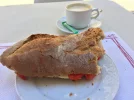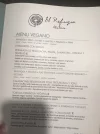Tom DeWolf
New Member
- Time of past OR future Camino
- Frances, Fall 2019
Portuguese plan: Summer 2025
Hello all... I've been following this forum for several months now, learning a lot along the way. I'll be walking my first Camino beginning in mid-September and will appreciate some recent, experienced input regarding the standard food available along the Camino Frances... breakfast, lunch, and dinner... pilgrim meals, etc. Though I am mostly vegetarian, I do eat fish. I haven't had any pork, chicken or beef in many years. I don't eat much cheese or eggs. That said, understanding that my preferred diet is a bit challenging for the Frances, I want to introduce the most common foods to my diet now so my body is used to them by the time I fly to Biarritz. I've read some threads about availability of veggie meals along the way, and found some posts about food that are several years old; just nothing recent. I've just decided to "go with the flow" so want to know what's simple to expect in terms of food types, variety, etc. Any shares here will be much appreciated, including links to other posts I may have missed.





























